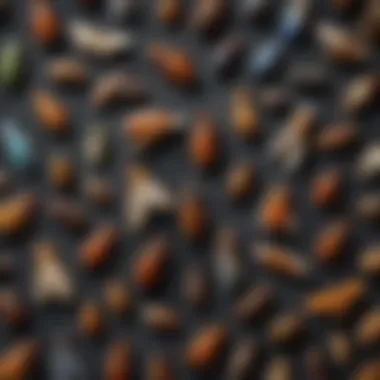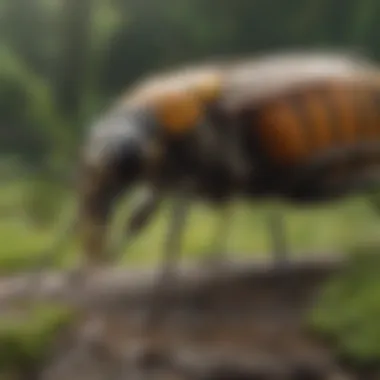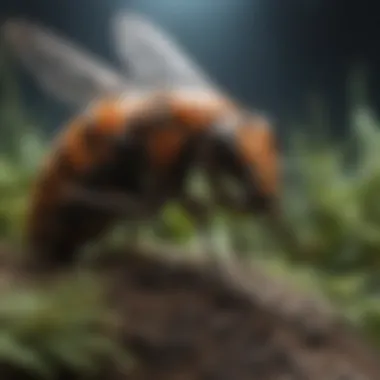Exploring the Insectarium: An Insightful Journey


Intro
The Insectarium in Philadelphia offers a profound gateway into the world of insects, a realm often unnoticed yet crucial to our ecosystem. This facility not only presents an array of species but also emphasizes educational initiatives and conservation efforts. Insects hold a significant place in our environment, acting as pollinators, decomposers, and food sources for many organisms. Through this article, we will explore the various aspects of the Insectarium, touching on its educational programs, species diversity, and the ongoing conservation work that aims to protect these delicate creatures.
Understanding our relationship with insects is vital. Many people regard them as pests or nuisances without appreciating their ecological contributions. By examining the significance of insects, we aim to foster a deeper understanding and ultimately a greater appreciation for these overlooked beings. This journey will encompass not only the exhibits and educational programs at the Insectarium but also its vital role in the research community, particularly concerning pest control and environmental balance.
As we delve into the specifics, we will address key topics such as pest identification, prevention methods, and DIY pest control solutions. These subjects are pertinent for homeowners and those interested in maintaining a friendly coexistence with insects. By navigating these layers, this guide serves as a comprehensive resource for a diverse audience, from enthusiasts to professionals in pest management.
Getting to know the Insectarium will help promote insight and awareness, bridging the gap between humans and insects, enhancing our environment and ecology.
Intro to the Insectarium
Understanding the Insectarium's role in education and conservation is crucial. It serves as a gateway for many to learn about insects, their behavior, and their significant contributions to the environment. This introduction paves the way for observing how insects, often regarded as pests, are integral to our ecosystem's balance. Each program and display is carefully curated to inform visitors about the complexity of insect life and habitats.
Location and Accessibility
The Insectarium is situated in Philadelphia, making it accessible to a wide range of visitors. It is conveniently located near public transportation routes. Those traveling by car can find ample parking nearby. Signage around the area also helps direct guests to the facility. Accessibility options, such as ramps and elevators, are in place to ensure that all visitors can enjoy the exhibit without hindrance. This focus on accessibility reflects an understanding of community needs and an effort to make educational resources available to everyone.
Purpose and Mission
The mission of the Insectarium is to educate the public about the importance of insects in our world. It aims to foster a deeper appreciation for these creatures while promoting research and conservation efforts. By highlighting species that are often overlooked or misunderstood, the Insectarium encourages a broader dialogue about biodiversity. This includes issues relating to habitat loss and the ecological impacts caused by human activity. Engaging the public in this manner is an essential mission that extends beyond its walls, reaching into schools and community programs to enhance environmental awareness and stewardship.
Architectural Design and Layout
The architectural design of the Insectarium is not just a backdrop for exhibits; it shapes the entire visitor experience. This carefully crafted environment serves multiple purposes: it enhances educational outreach, facilitates research, and fosters a connection between the public and the often-overlooked world of insects. The layout plays a vital role in how visitors engage with the displays, highlighting both the aesthetic appeal and scientific significance of insects in their daily lives.
Exterior Features
The exterior of the Insectarium captivates visitors even before they step inside. The facade is designed with large windows that allow light to flood the interior, creating a welcoming atmosphere. This reflects the mission of the facility to make the study of insects accessible and inviting. The architectural elements include vibrant colors and patterns that mimic various insect habitats, drawing attention and piquing interest.
Landscaping is another critical aspect of the exterior features. Native plants surround the building, creating a habitat that attracts local insects. This not only enhances the natural beauty but also serves as an educational tool. Visitors can observe how these plants interact with local insect populations.
Interior Exhibits
Upon entering the Insectarium, the layout is thoughtfully designed to guide visitors through various themed exhibits. Each area showcases different aspects of insect life, ensuring a logical flow that is easy to navigate. This organization benefits both casual visitors and those seeking a more in-depth understanding of entomology.
The interior is divided into sections that represent different ecosystems, from tropical rainforests to temperate woodlands, reflecting the biodiversity of insect species. Inside, the exhibits are interactive, allowing visitors to engage with the material. For example, some displays might have touch screens with detailed information about specific species, while others might feature live specimens.
Lighting plays a significant role in the interior design as well. Various setups highlight the unique colors and behaviors of insects while creating a dynamic ambiance. Natural light is maximized through the windows, augmented by artificial lighting that mimics sunlight, enhancing the vibrancy of the exhibits.
"The Insectarium’s design not only educates but also inspires curiosity about the insect world, encouraging visitors to think critically about their relationship with the environment."
Overall, the architectural design and layout of the Insectarium enhance both the educational and experiential components. This type of careful planning allows the facility to fulfill its mission of educating the public about the importance of insects in our ecosystem.
Collection of Insects
The collection of insects at the Insectarium plays a vital role not just in showcasing the variety of species that inhabit our planet, but also in fostering a deeper understanding of their ecological importance. Bugs can be fascinating, yet many people overlook their significance in everyday life. This section delves into the essential elements of the insect collection, emphasizing its benefits and considerations.
Diversity of Species
The diversity of species found in the Insectarium's collection is staggering. Visitors can expect to encounter myriad insects ranging from the beautiful Morpho butterflies to unique stick insects. Each species provides valuable insights into the role insects play in various ecosystems. A diverse insect collection helps educate guests on the interconnectedness of life on Earth.
Insects contribute to pollination, decomposition, and are part of the food web. Various species also exhibit different adaptations. This ranges from camouflage techniques used by stick insects to the vibrant patterns found on butterflies, illustrating the beauty of evolution. By understanding this diversity, visitors appreciate the complexity of the environmental systems that insects support.


Unique Insect Specimens
Within this collection, unique insect specimens stand out for their rarity and biological significance. For example, the Giant Weta from New Zealand is not only unusual in size, but its survival is threatened by habitat loss. This teaches visitors about conservation issues that insects face and their potential extinction.
Other specimens might include insect species that have special adaptations. The Bombardier beetle, known for its ability to expel a hot toxic spray as a defense mechanism, serves as an excellent example of evolutionary innovation. Exhibits of these specimens encourage discussions about the delicate balance necessary to maintain biodiversity.
Rarity and Conservation Status
The rarity and conservation status of the insect collection is a critical aspect to address. Many insects are facing threats from habitat loss, climate change, and pollution. The Insectarium aims to raise awareness about these issues by featuring specimens that illustrate these challenges.
By showcasing species that are endangered or threatened, the facility advocates for the importance of conservation efforts. Exhibits often include information about the IUCN Red List, which classifies the conservation status of various species. This elevates the message that conservation is not solely for charismatic animals like tigers or elephants, but also for the small, often ignored, members of the animal kingdom.
Conservation of insects is crucial for ecosystem health; their decline can disrupt food webs and degrade soil health.
Understanding this context enriches visitors' experience and emphasizes the need for informed action in conserving insect populations. A thoughtful approach to the collection encourages individuals to appreciate the quiet yet impactful roles insects play both locally and globally.
Educational Programs and Workshops
Educational programs and workshops at the Insectarium in Philadelphia play a crucial role in increasing appreciation and understanding of insect life. These initiatives offer a platform where participants can learn about the complexities of insect ecosystems and their significant roles in our environment. Programs are tailored to different age groups and interests, making them accessible and engaging for everyone.
Programs for Schools
The Insectarium provides specialized programs for schools, aiming to enhance the educational experience of students. These programs align with educational standards and offer hands-on learning opportunities. Students engage in activities that promote curiosity about the natural world and its inhabitants.
Every program includes guided tours through various exhibits and interactive sessions. Some topics may include life cycles, habitats, and the importance of insects in our ecosystem. Teachers can easily integrate these programs into existing curricula, allowing them to address science standards while also encouraging real-world exploration. These experiences are designed to cultivate a sense of responsibility towards nature, as students learn about conservation and biodiversity.
Workshops for Enthusiasts
Workshops for enthusiasts cater to individuals passionate about entomology or just curious about insects. These sessions cover a range of topics from basic identification skills to advanced ecology and conservation practices. Participants can learn from experts, fostering a deeper understanding of insect behavior and adaptations.
Engagement in practical activities, such as collecting and studying insects, provides valuable experiences and skills. Attendees also get the opportunity to network with other insect lovers. It's a space where knowledge is shared, and new interests may spark.
Overall, these educational offerings enrich the visitor experience at the Insectarium and contribute to a broader dialogue on ecological significance, conservation efforts and sustainable practices. Insects, often overlooked, are presented as vital players in our world.
Research and Scientific Contributions
Research conducted at the Insectarium in Philadelphia plays a vital role in enhancing our understanding of insect life. This research not only focuses on the cataloging of diverse species, but also addresses the broader implications of insect behavior and their importance to ecosystems. The institution engages in collaborations with various academic bodies, fostering a synergistic approach to knowledge sharing and practical applications.
Collaborations with Universities
The Insectarium collaborates with several universities to promote entomological research. This partnership provides students and researchers access to a vast collection of insects for study. Through these collaborations, the Insectarium enables academic pursuits that might lead to new discoveries in insect behavior, physiology, and taxonomy. These research findings contribute to the scientific community’s understanding of biodiversity and the ecological roles of insects.
Moreover, such partnerships often involve internships and volunteer opportunities, allowing university students to gain hands-on experience. This not only enriches their education but also magnifies public engagement with entomology. Some universities involved in this research include the University of Pennsylvania and Temple University. Together, they create a comprehensive network that strengthens scientific inquiry and education.
Impact on Environmental Science
The scientific contributions of the Insectarium extend beyond academic research. By studying insects, researchers can better understand environmental dynamics. Insects are integral to various ecological processes, serving as pollinators, decomposers, and indicators of environmental health. This knowledge is crucial for formulating conservation strategies and managing biodiversity.
Insect research conducted at the Insectarium also influences pest control and agricultural practices. By studying the interactions between pest and beneficial insects, the Insectarium helps develop sustainable pest management practices. This research not only contributes to increased crop yield but also reduces the reliance on chemical pesticides, promoting better environmental health.
"Understanding insect behavior and interactions is not just academic; it has profound implications for sustainable practices and ecosystem management."
As climate change continues to pose challenges, the Insectarium’s research helps in monitoring changes in insect populations and their effects on the environment. This work informs public policy and conservation efforts.
Overall, the research and scientific contributions made by the Insectarium benefit not only the scientific community but also society at large. These efforts create a greater appreciation for the often-overlooked role that insects play in maintaining ecosystem balance.


Insect Behavior and Adaptations
Insects are complex creatures with behaviors that are essential for their survival. Their adaptations are remarkable and serve various functions, from finding food to ensuring reproductive success. This section explores the intricate behavioral patterns and adaptations that define insect life. Understanding these aspects not only highlights their ecological roles but also informs us about the dynamic interactions within ecosystems.
Social Structures
Insect social structures exhibit a diversity that is truly fascinating. Many species, such as ants, bees, and termites, are known for their highly organized societies. These insects often live in colonies where individuals have specific roles, contributing to the overall efficiency of their community.
- Roles within Colonies: In species like honeybees, there exist roles such as queens, workers, and drones. Each type has a distinct responsibility. The queen lays eggs, workers gather food, care for young, and drones mate with queens.
- Communication: Communication among social insects occurs through pheromones, sound, and movements. Ants use these chemical signals to inform others about food sources or dangers.
- Cooperative Behavior: Cooperative behavior is another hallmark of social insects. This can be seen in how ants work together to build nests or how bees will protect their hive from intruders. Such coordination enhances their collective survival.
In this way, social structures of insects illustrate a complex organizational hierarchy that enhances their chance of survival in varying environments.
"Understanding the social structures of insects offers insights into organization, communication, and survival strategies that are often overlooked in nature."
Survival Mechanisms
Survival mechanisms in insects are crucial to their existence in a world full of threats. These mechanisms include physical adaptations, behavioral responses, and reproductive strategies.
- Camouflage and Mimicry: Many insects employ camouflage to blend in with their surroundings. For instance, stick insects resemble twigs, while leaf insects mimic leaves. This adaptation provides an advantage against predators.
- Defense Strategies: Various insects possess defense mechanisms. Some may produce toxins, while others have physical features like thorns or hard shells. Beetles, for example, can secrete harmful substances to deter predators.
- Reproductive Strategies: Insects also develop unique reproductive mechanisms. Some species exhibit behaviors that maximize the chances of offspring survival, such as laying eggs in protected environments. The complexity of these strategies ensures that insects adapt and thrive, even under environmental pressures.
Importance of Insects in Ecosystems
Insects play a critical role in maintaining the health and functionality of ecosystems. Their contributions span various domains, including pollination, soil health, and food webs. Understanding their importance helps us appreciate not just their existence, but also their contributions toward sustaining life as we know it.
Pollination and Food Webs
Pollination is one of the most significant roles that insects perform within ecosystems. Many plants rely on insects to transfer pollen, allowing for reproduction and the generation of fruits and seeds. For instance, bees, butterflies, and beetles are among the main pollinators that disrupt often silent but critical processes.
Without these insects, many of the crops we depend on for food, such as fruits and vegetables, would see reduced yields or complete crop failures. A staggering 75% of global food crops depend on insect pollination. This connection between insects and food production illustrates the profound impact that these small creatures have on human nutrition and agricultural economy.
Moreover, insects serve as a foundational element in food webs. They are a primary food source for various species, including birds, amphibians, and mammals. This interdependence underscores the fragility of ecosystems when insect populations decline. The ripple effect of losing these insects can lead to diminished populations of wildlife that depend on them for survival.
Decomposition and Soil Health
Beyond pollination, insects also play a vital role in decomposition and improving soil health. Detritivores, such as ants and certain beetles, contribute to breaking down organic matter. This natural process recycles nutrients back into the soil, fostering a rich environment for plant growth. In their search for food, insects aerate the soil, which improves water infiltration and root growth.
Healthy soils are essential for growing sustainable crops. Insects like earthworms, although not insects per se, are influenced significantly by insect activity. They rely on decaying organic matter produced by insects. Therefore, the health of the soil is intricately tied to the population and activity levels of insects.
"Insects, by their actions, support functions that sustain ecosystems and, ultimately, human life."
In summary, understanding the roles of insects in ecosystems reveals their indispensable value. From aiding in pollination processes that directly affect our food supply to maintaining the health of our ecosystems through soil enhancement, insects are vital. Their presence ensures a balanced environment, illustrating that each species, no matter how small, is essential to the broader ecological narrative.
Pest Control Strategies
Pest control is a significant focus for homeowners and it helps maintain both comfort and health in living environments. Understanding modern pest control strategies is more crucial than ever. This not only aids in managing unwanted insects but also encourages beneficial relationships with other species. The Insectarium provides insights into these strategies that align with both education and action.
Understanding Pest Insects
Pest insects can be defined as species that negatively impact human activities, health, and comfort. Common pest insects include ants, cockroaches, flies, and bed bugs. Each of these insects behaves in a unique manner, requiring tailored strategies for effective management.
Some crucial aspects to understanding pest insects include:
- Identification: Correct identification helps in determining the most effective control methods. Knowing whether the insect is a carpenter ant or a fire ant affects the strategies you should employ.
- Behavior: Understanding when and where pests are active assists in planning interventions. For instance, some insects are drawn to food sources, while others prefer dark, humid areas.
- Life Cycle: Recognizing the life cycle of pest insects helps in applying treatments at the right time. For example, targeting young nymphs can prevent future infestations.


"An informed approach not only tackles the current issue but helps prevent future pest incursions."
Integrated Pest Management
Integrated Pest Management, often shortened to IPM, is a multifaceted approach to managing pest issues. This strategy emphasizes the integration of various control methods and sustainable practices to minimize negative impacts on both human health and the environment.
Some key components of IPM include:
- Monitoring and Identification: Regular inspections help track pest populations and determine the species involved. This data guides the choice of appropriate control methods.
- Prevention: Preventive measures involve securing food sources, sealing entry points, and maintaining cleanliness. These steps significantly reduce the likelihood of pest infestations.
- Control Methods: IPM advocates for a balanced combination of chemical, biological, and cultural control methods. This could involve using natural predators, setting traps, and, if necessary, applying pesticides in a targeted manner.
- Evaluation: After implementing control methods, it's vital to evaluate their effectiveness and adapt accordingly. Continuous monitoring allows one to shift strategies as needed.
Visitor Experience and Accessibility
Understanding the Visitor Experience and Accessibility at the Insectarium in Philadelphia is essential in accomplishing its wider mission of education and conservation. This section outlines key components that enhance the visitor experience, making it enjoyable and informative. Visitors, especially housewives and homeowners, should know how to plan their trips effectively and fully utilize the available amenities.
Planning Your Visit
Planning a visit to the Insectarium involves a few key considerations. The first step is checking the Insectarium's website for hours and special events. Being aware of peak visiting times can help avoid large crowds and ensure a more intimate experience with the exhibits.
Ticket options are varied, which can include:
- General admission for adults
- Reduced prices for children, students, and seniors
- Family packages that provide a discount for multiple entries
It is advisable to purchase tickets online in advance. This minimizes waiting times at the entrance and allows for a smoother start to the visit. Additionally, checking the Insectarium’s calendar for events such as guided tours or special workshops can enhance the learning experience.
Accessibility is also a critical factor. The Insectarium is committed to ensuring that all visitors can enjoy the exhibits. Wheelchair accessibility is provided throughout the facility, and specific resources are available for those with other disabilities. Informing staff of any special requirements will make the experience more comfortable.
Facilities and Services
Once arrived, the facilities at the Insectarium enhance the overall experience. Key services available to all visitors include:
- Restrooms equipped with baby changing stations
- A gift shop that offers educational materials, souvenirs, and insect-themed merchandise
- Areas to rest or have a light bite, ensuring a leisurely visit
Furthermore, staff members are trained to assist visitors with questions about exhibits or programs. Their knowledge enriches the experience by providing insights into insect life that are not immediately apparent.
While many think insects are just pests, this facility shows their importance through displays and engaging programs.
Lastly, the Insectarium often hosts seasonal events and school programs that encourage family participation. These programs are designed to engage children and adults in exploring the fascinating world of insects. In summary, planning is crucial to maximize the visit while the facilities ensure comfort and accessibility.
End: The Future of the Insectarium
Insectariums play a crucial role in education and conservation efforts regarding insects. The future of the Insectarium in Philadelphia revolves around its ability to adapt and innovate in an ever-changing environmental landscape. This section provides insight into specific elements and benefits of the institution's ongoing efforts.
Sustainable Practices
Sustainable practices are at the heart of modern insectariums. The Insectarium in Philadelphia commits to minimizing its environmental footprint while maximizing educational impact. This includes strategies such as:
- Eco-friendly exhibit designs: Exhibits are constructed using sustainable materials. This not only reduces waste but also serves as an educational tool for visitors.
- Responsible sourcing of species: The Insectarium prioritizes local species when possible. This practice helps maintain biodiversity in the region and promotes awareness of native insects.
- Waste management initiatives: Recycling and composting programs are implemented. This reduces the amount of waste sent to landfills and encourages visitors to consider their own waste impact.
The importance of these sustainable practices lies in their dual role. They not only enhance the visitor experience but also foster environmental stewardship among the community. By integrating sustainability, the Insectarium becomes a model for other institutions on how to blend education with eco-consciousness.
Ongoing Developments
The Insectarium continuously evolves through various ongoing developments. These advancements are crucial for attracting new visitors and maintaining relevance in the educational field. Key focus areas include:
- Expansion of educational programs: Targeting facilities and outreach within schools, the Insectarium is dedicated to enhancing its curriculum. This allows it to offer diverse workshops that cater to various age groups.
- Research collaborations: Ongoing partnerships with universities and research institutions bolster scientific inquiry. These collaborations expand the knowledge base about insect behavior and ecology, which is shared with the public through exhibits and workshops.
- Technological integrations: The use of technology in exhibits provides interactive experiences. Virtual reality and app-based learning are emerging tools that engage visitors in unique ways.
These developments not only enhance the educational aspect of the Insectarium but also ensure that it remains a relevant and pivotal institution, advocating for insects and their importance to ecosystems. The continuous evolution leads to greater visitor engagement and understanding, paving the way for future generations to appreciate the relevance of insects in our lives.
The Insectarium embodies a nexus of science, education, and sustainability, making it a vital resource in Philadelphia.
The future of the Insectarium is bright, marked by ongoing innovations that foster appreciation for insect life and environmental health.















